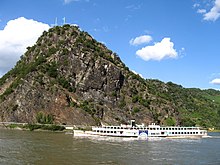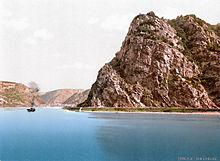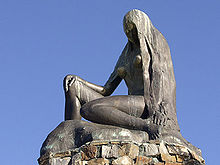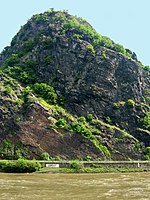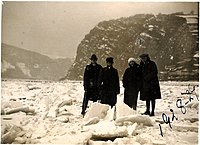Loreley


The Loreley (also Lorelei , Loreleï , Lore Lay , Lore-Ley , Lurley , Lurelei , Lurlei ) is a slate rock in the UNESCO World Heritage Upper Middle Rhine Valley near Sankt Goarshausen , Rhineland-Palatinate , located on the eastern, right bank of the Rhine (at Rhine kilometer 555) 132 meters ( 193.14 m above sea level ) towering steeply on the inside of a curve in the Rhine. The view from above of the Rhine curves and Sankt Goarshausen with theKatz Castle is a magnet for tourists. A few hundred meters from the vantage point is the Loreley open-air stage , built in 1939 , where major events (such as rock concerts) regularly take place.
Loreley has Clemens Brentano in his novel Godwi ( 1801 ) narrated in ballad form Kunstmärchen Lore Lay also the name of a sorceress or mermaid on this rock. Brentano's invention had in place such a strong reception that even before the mid-19th century his story as old legend (as a "fable of old Times", see The Lore-Ley from Heinrich Heine was stylized). However, the content of this pseudo-saga told by Brentano, Heine and others is clearly linked to mythologems already known from Greek mythology, such as that of the nymph Echo , who is transformed into a rock, that of the magical gaze, against which the one looked at is defenseless, or the fatal song of the sirens for boatmen . Brentano's Lore Lay attracts every man with her beauty and thus brings him to death. Heinrich Heine concretizes this with the boatmen who crashed in the Rhine and are distracted by the singing of the Loreley.
Location and surroundings
The Loreley rock is located in the Rhein-Lahn district in the area of the Loreley community . The Loreley Plateau is part of the Bornich community , while the steep slopes and cliffs rising up from the Rhine all around belong to the urban area of Sankt Goarshausen. The Loreley lies in the center of the natural area St. Goarer Tal as part of the natural spatial main unit of the Upper Middle Rhine Valley .
The river bed of the Middle Rhine , which is 300 meters wide above the Kammereck, is narrowed to 145 meters by the rock barriers just above the Loreley, on the Betteck. At the Loreley itself, the Rhine is 160 meters wide and up to 25 meters deep. These are the narrowest and deepest parts of the Rhine on its navigable section. On the other hand, the two banks of the river, directly downstream, at the Loreley harbor, diverge like a trough for a short distance up to 400 meters apart. At Sankt Goar and Sankt Goarshausen the stream is usually 250 meters wide. The Rhine winds in tight curves through the rock massif.
Because of these very tight bends and strong currents which is Rhine from Bankeck in Sankt Goar up to Oberwesel by light signal sites regulated. However, some rocks on the Loreley were blown up in the 1930s, so that the Loreley Passage has lost much of its earlier dangerousness. Nevertheless, pilots were used on the route from St. Goar to Bingen am Rhein until the 1980s .
The right Rhine line of the railway has tunneled under the Loreley rock and the Roßstein, opposite Oberwesel. The West Rhine Railway must because of the sharp turns three times in the tunnel, namely on Bankeck, on Betteck and on Kammereck.
Surname
The origin of the name Loreley is not clear. The connection with the originally Celtic Ley , with which (slate) rock or stone was often used in the region, is undisputed . The first part could come from the Middle High German luren (lurking) and thus mean overall "lurking rock". A derivation from the Middle High German lorren or lurren , which means "howl" or "scream", would also be conceivable . So the rock would be a screaming rock. This could be attributed to the fact that many boatmen perished on the Loreley rock in the dangerous reefs, rocks and shallows.
The Rhine narrows at the Loreley to a width of around 200 meters. At the same time, the deepest point of the navigable Rhine is located here at around 25 meters ( the Rhine reaches a depth of 32 m near Rheinfelden in Switzerland, see St. Anna-Loch ). Another possible origin of the word lore is the Rhenish luren , which means "to hum". This could be interpreted as the hum of the water along the rocky reefs. The origin of the Middle High German lur for "elf" is also possible. In this case it was an elven rock. For the strong sevenfold echo, dwarfs who lived in the rock were initially held responsible. The rushing of the high Galgenbach waterfall opposite the Loreley rock and also the rushing of the Rhine current, which used to break on shallows and cliffs, was reflected down as an echo from the many rock overhangs and appeared as if it came from the rocks. Explanations were sought early on, and dwarfs living in caves in the rock were initially responsible. Before the 19th century, the place also had its masculine article: the Lurlei , the Lorley or the Lurleberch (numerous other spellings).
history
The Loreley was already a well-known place in the Middle Ages, on the one hand because of the striking rock as a waymark , on the other hand because of the dangerous place for shipping. Next to the Binger Loch was here, a little down the Rhine towards St. Goarshausen / St. Goar about at the height of today's campsite, the most dangerous place for navigation on the Rhine. At this point, with the green ground, lay a sandbank in the Rhine, on the left side of which the water tumbled over the “Gewerre” (rock ribs lying across the river), while it could flow off on the other side. The differently fast flowing water masses met behind the sandbank, creating strong eddies there that were fatal for many boaters. Before most of the reefs were blown up in the last century, the boatmen had asked their crews to pray with three bells before they passed the Loreley. For this reason, the holy Goar settled here, who tried to save and care for shipwrecked people. Since 1395, vineyards belonging to the Katzenelnbogen counts can be found on the rock .
A visitor center with a museum has existed since 2000. It provides information on site about the culture, economy and nature of this region. The summer toboggan run Loreley was opened in 2013 on the plateau of the Loreley rock . Before the construction of the railway, there were discussions between politicians, citizens and environmentalists for several years. In the meantime, UNESCO has requested its dismantling, as it is part of the UNESCO World Heritage Site of the Upper Middle Rhine Valley .
Shipping accidents
Even if the most dangerous rocks in the fairway have been blown up, the journey through the Loreley Passage is still associated with a particular risk, especially with exceptional water levels.
So ran on 28 September 2003 at extreme low tide the passenger ship Loreley the Cologne-Düsseldorf German Rheinschiffahrt AG (KD) with 349 passengers and eleven crew members on board when plummeting due. With a draft of 1.24 m and a depth of the fairway of 1.44 m, the ship initially hit the ground for an unknown cause, which caused the twin propellers used for propulsion and steering to fail. The incapable of maneuvering the ship then ran into the sharp right bend of the river directly at the height of the Loreley rock on the left bank. In the abrupt stop, 41 people were injured on board, three of them seriously. The ship had to be evacuated and towed free. After the accident, the KD stopped all trips between St. Goar and Rüdesheim as a precaution for the duration of the low water. At the time of the accident, the Kaub gauge was at a record low of 35 centimeters.

On January 13, 2011, the tanker motor ship Waldhof, loaded with 2,400 tonnes of concentrated sulfuric acid , also capsized while descending near the Loreley rock and remained lying on the port side off St. Goarshausen. An expert opinion later revealed that the poor stability of the ship caused by improper loading had led to the accident. Two of the four crew members were rescued from the four-degree cold water. At the time of the accident, there was flood on the Rhine . At 1 p.m., the Kaub gauge stood at 5.72 m, well below the high water mark II (6.40 m level), which will stop shipping if it is exceeded. As a result of the accident, the Rhine had to be closed for weeks at the height of the wrecked ship, which could only be recovered on February 13, 2011, which led to a significant congestion on the waterway.
The Loreley as a legendary figure
Already in the Middle Ages , dwarfs , nymphs and mountain spirits were held responsible for the dangerous currents and the echoes on the Loreley rock. But initially there is no talk of a woman named Loreley .


The first to transfer the name of the rock to a person and thus create an art legend was the poet Clemens Brentano ; the origin of the echo on the Loreley rock found a new explanation. He probably connected the echo rock with the ancient myth of the nymph Echo, who froze into a rock out of grief over the loss of her lover, from which her voice resounded as an echo. In his novel Godwi or Das Steinerne Bild der Mutter (1801-1802), Clemens Brentano wrote a ballad about Lore Lay , an eponymous woman who is thought to be a sorceress because of her attraction to men and who finally falls from the rock of the same name because of her heartache. The legend of the Loreley corresponds thematically to the romantic worldview . Popular scenes of romantic poetry are mist-shrouded forest valleys, rivers, ruins, old castles, caves and mountain interiors. These are also the locations used by Brentano.
This Brentano ballad provided the impetus for further stories with a female figure of the same name at the given location. There are ballad versions by Joseph von Eichendorff , Otto von Loeben and others, but the most famous is the poem by Heinrich Heine . It shaped the figure of the Loreley as a kind of mermaid , who, like a siren, casts a spell on the Rhine boatmen with her singing and her beauty, whereupon they perish due to the dangerous currents and the rocky reefs.
Clemens Brentano's ballad
In 1801, Clemens Brentano wrote in the ballad Zu Bacharach am Rheine… (originally part of the novel Godwi or The Stone Image of Mother ) about a sorceress who, because of her beauty, robs all men of their minds and ultimately always brings them death. Therefore she should be sentenced to death as a witch by spiritual violence. Lore Lay is aware of its effect and is tired of this circumstance - since her lover cheated on her and has to spoil her in her “magic circle”, she has wished to die. However, due to Lore Lay's beauty, the bishop cannot utter a death sentence and instead sends her to a monastery. On the journey there, accompanied by three knights, Lore asks Lay on a large rock to climb it and see the Rhine again from above. She climbs the rock and falls down. A footnote refers directly to the Loreley rock near Bacharach am Rhein.
The ballad begins like this:
A
sorceress lives at Bacharach am Rheine ,
She was so beautiful and delicate,
And she wore a lot of hearts.
And brought much shame to
the men around,
From their bonds of love there
was no more salvation.
According to an interpretation published by Werner Bellmann in 1978, the Lore Lay ballad is a variation of the ancient echo myth. (Out of grief over her spurned love for Narcissus, the echo becomes a rock from which her voice resounds as an echo.) When drafting his poem, Brentano relied on a versed paraphrase of Ovid's “Metamorphoses” published in 1631 , which can be found in in his possession and which he used for several lyrical passages of his novel "Godwi". According to Bellmann's thesis, the Lore-Lay ballad is an etiological story invented by Brentano , which, following on from the ancient echo myth, “explains” the origin of the echo on the Loreley rock near St. Goarshausen . At the beginning of the history of the impact - the popularization - of Brentano's ballad is the depiction of Niklas Vogt (1756–1836) from the year 1811: “This lurelei, or rather its echo, should be the voice of a woman, which enchants all men with its extraordinary beauty just not the one she loved herself. ”In a footnote, Vogt refers to Brentano's poem.
Clemens Brentano's Rhine fairy tale
Brentano took up the theme of Lorelei in his Rheinmärchen (1846/1847). Here, however, Lorelei is no longer the girl from Bacharach, but a fairy figure. In the fairy tale of the Rhine and the Müller Radlauf , a tragedy during the wedding ceremony between Prince Rattenkahl of Trier and Princess Ameleya of Mainz creates a deep enmity between their two kingdoms. In the course of the story a little goldfish tells of having seen strange lights with a miraculous shimmer, which came from a round opening in the floor. Aquarius talks about it with the white main and the red main. He says that this is the Nibelungen hoard. The red main wants to know where the seven courses lead. They led to seven golden doors, behind which there were seven flights of stairs. These in turn would wind their way up into a hall. Lureley sat there on seven thrones, with her seven daughters next to her. Lureley is described as a sorceress, with a beautiful body and a clever mind. The beautiful castle is surrounded by rugged rock and the Rhine roars wildly by. Lureley is called the guardian of the Hort (Nibelungenhort). She wakes up and sings as soon as she hears a boatman. Mrs. Lureley is described here as a daughter of the imagination. She is the daughter of fantasy and echo. Some of their children are mentioned by name. It's echo, chord, and rhyme.
As the story progresses, Loreley reappears. This time the sinking of a ship is associated with her for the first time. The motif that a woman is sitting on the rock and combing her golden hair also appears here. The Müller Radlauf tells of a stormy day on which they took the boat on the Rhine. He looked up into the rock and saw a beautiful young woman with a black skirt and white veil. She was in deep grief and cried while combing her long blonde hair. Then the ship gets into a vortex, turns and is swung down with a jerk. Radlauf sinks into his boat and comes to an arbor at the bottom of the Rhine. Here he meets Lureley. She sits on a water lily and is surrounded by seven virgins, who are her daughters. Lureley does not notice him and sings with the virgins. She is described as a lovely woman who casts Radlauf completely under her spell. She is a beautiful blonde woman and has a very gracious expression. So she takes Radlauf by the hand and leads him around. The dear blonde water maiden brings him into the room of his ancestors, four old men. Lureley is also described here as a dear blonde mother.
Another Ms. Lureley later appears. At first she is a young mermaid, then she uses the appearance of a pretty peasant girl to take on human form. She is loyal because she returns three times to her great love Christel, although he has betrayed her three times. The mill miners and Lureley's children also betrayed them. Eventually she lost three of her children and leaves the last one with Christel. She withdraws to her castle, the Lureley rock near St. Goar, and takes on the shape of a water maiden again. Here she lives with Mrs. Echo and her seven daughters and manages the fate of the dead. All facets of love play a role here, because every daughter stands for a quality of love: heartache, love sorrow, love oath, love envy, love joy, remorse and sorrow, mildness. She is a beautiful, gentle woman who, however, has a broken heart because she has often been betrayed by her loved one and loved ones. Lureley often sits sadly on her rock by her castle, crying, singing and combing her long blond hair. If she is mocked by boatmen passing by, she will drag them down to death.
A lureley appears one more time in the story. This time she is a traveling water maiden. She is described as beautiful, good and friendly and wears very nice clothes. Her hair is long and blonde. Lureley can use it to rain pearls and gold and also do other magic. She likes to help good people, but condemns bad people. She doesn't comb her hair herself here, but lets a girl do it. Lureley is a helping, loving water woman.
Heinrich Heine's song about the Loreley
Main article: The Lore-Ley
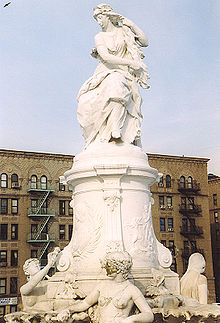

Heinrich Heine took up the subject in 1824 in his most famous poem, which went down in literary history under the title Die Lore-Ley . It was spread mainly through the setting by Friedrich Silcher (1837). He used motifs and means of representation from romanticism and folk songs in order to ironize them (through accumulation and exaggeration, also through excessive pathos) and in this way to distance himself. The combination of vanity, seductiveness and transience points to the revival of the vanitas motifs in Romanticism. In the 19th century, in addition to the popular song versions by Silcher, over forty others were created. In 1841 and in a revised version in 1856, the poem by Franz Liszt was set to music under the title Die Loreley ( Searle 273) as a song for piano and voice. Liszt made additional arrangements for piano solo in 1861 (Searle 532) and voice and orchestra in 1860 (Searle 369). With its tone painting and its differentiated scenic depiction of mood, it cannot be compared with Silcher's simple folk tune. Clara Schumann set the text to music in 1843 as a song for piano and voice. Heine's Lore-Ley was received as a sentimental folk song for a long time, especially in the 19th century.
Adaptations of the Loreley material
- Felix Mendelssohn Bartholdy was planning an opera on the subject (Op. 98, unfinished).
- In 1884, Mary Koch (d. I. Marie Leinweber) wrote a Rhine legend in eleven songs with the title "Loreley". Stuttgart, Barth, 1884.
- The Berlin composer Paul Lincke brought out an operetta under the title Fräulein Loreley in 1900 .
- Max Bruch , Alfredo Catalani , Hans Sommer , Fredrik Pacius and William Vincent Wallace composed operas entitled "Loreley" on this theme.
- Shostakovich set Brentano's ballad to music in a adaptation by Apollinaire in the 3rd movement of his 14th symphony .
- In 1932 George Gershwin had the Loreley praised as the “easy girl” in the musical “ Pardon My English ” set in Germany .
- Lenny E. Hoffmann composed the musical "Loreley" in 1993 with the London Symphony Orchestra and Chris Kempers as Loreley. From May to September 1993 the musical was performed on the Loreley open-air stage.
- Lene Voigt satirized the subject with her poem "De Säk'sche Lorelei".
- In his play “Ami go home!” Ernst Busch warned Americans not to steal the Loreley's golden comb and urged him to stay on his longitude.
- Erich Kästner wrote a satirical poem with the title “ The handstand on the Loreley ”, in which he refers directly to Heine's poem
- In 1954 Dietmar Kivel, Heinz Korn and Franz Norden created the carnival-Schunkel-Waltz Lore, leih '(me your heart ...).
- The folk-punk group “ The Pogues ”, the US band Styx , the Roxy Music spinoff “The Explorers” and the English rock band Wishbone Ash released tracks called Lorelei .
- Various medieval bands also wrote songs about the Loreley, among them the bands " Schandmaul " (Das Seemannsgrab) and " Die Streuner " (Die Ballade der Loreley, setting of Clemens Brentano's ballad, as well as handstand on the Loreley, a cheerful setting of Erich Kästner's poem ). The music band Theater of Tragedy also wrote a song called "Loreley" that sings about the Loreley, as did the American medieval group Blackmore's Night .
- The Munich comedian Karl Valentin recorded a parody of the Loreley song. The Loreley complained about the cold winds on top of the rock and their " Saubronchitis ".
- In the film " Johnny Flash ", Helge Schneider himself appeared as Loreley in one scene. Mainly for the sake of the director Werner Nekes , he takes up the version of Karl Valentin.
- “Loreley”, picture painted between 1955 and 1963 by the surrealist artist Edgar Ende (oil on linen forest).
- The Scorpions album , " Sting in the Tail " also has a track named Lorelei .
- Eagle Eye Cherry goes in search of Loreley in the song "When Mermaids Cry".
- In the Star Trek series " The Enterprise " there is an episode called "The Lorelei Signal". In it, spaceships are lured into a trap by a signal that resembles a singing woman's voice and evokes erotic visions in men.
- The group Dschinghis Khan had great success in 1981 with the German hit "Loreley".
- In the film " Rossini - or the murderous question of who slept with whom " by Helmut Dietl (1997), the focus is on the protagonists' efforts to make a film of Jakob Windisch's fictional novel The Loreley ; Although potential producers and directors consider a film version to be a financial “multi-million steel storm” - the novel is already a bestseller - the author cannot be won over to the project.
- In 1998 Kai Meyer wrote a gothic novel from the Middle Ages with his work "Loreley" .
- Harry M. Deutsch: The song of the Loreley (from the Swedish by Anne Görblich-Baier). A novel about a 1500 year old mystery to the present day. Eisbär-Verlag, Berlin 1998, ISBN 3-930057-47-6 .
- Achim Reichel recorded his version of the Silcher setting for his 2002 album "Wilder Wassermann".
- Marina Grünewald (Ed.): Loreley. The magic fairy from the Rhine. Smaragd-Verlag, Woldert (Westerwald) 2003, ISBN 3-934254-63-2 (Contains 16 short texts - poetry and prose - with the Loreley material.)
- In the manga and anime series Die Monster Mädchen a mermaid named "Melu Loreley" appears.
- The song "Loreley", released in 2019 by the industrial metal band Lord of the Lost , deals with the female legendary figure "Loreley", whose task it is to guide the dead from the earthly world into the realm of souls.
Ice jam on the Loreley in winter 1928/29
Research literature
- Helga Arend: The Loreley - Development of a literary figure into an international myth. In: Liesel Hermes, Andrea Hirschen, Iris Meißner (eds.): Gender and interculturality. Selected contributions from the 3rd symposium on women / gender research in Rhineland-Palatinate (= women and gender research in Rhineland-Palatinate. Volume 4). Stauffenburg-Verlag, Tübingen 2002, ISBN 3-86057-794-8 , pp. 19-28.
- Jürgen Behrens, Wolfgang Frühwald, Detlev Lüders (eds.): Historical-critical edition, organized by the Free German High Foundation. Brentano. All works and letters. Volume 16: Godwi or The Stone Image of the Mother . Edited by Werner Bellmann. W. Kohlhammer, Mainz, Cologne, Berlin, Stuttgart 1978.
- Werner Bellmann: Brentano's Lore Lay ballad and the ancient echo myth. In: Detlev Lüders (Ed.): Clemens Brentano. Contributions to the colloquium in the Free German Hochstift 1978 (= Free German Hochstift. Volume 24). Niemeyer, Tübingen 1980, ISBN 3-484-10369-8 , pp. 1-9.
- Rotraud Ehrenzeller-Favre: Loreley, origin and change of a legend. Hoops, Zurich 1948.
- Elisabeth Frenzel : Substances of world literature. A lexicon of longitudinal sections of the history of poetry (= Kröner's pocket edition . Volume 300). 9th, revised and expanded edition. Kröner, Stuttgart 1998, ISBN 3-520-30009-5 .
- Manfred Halfer: Loreley - a contribution to the interpretation of names. In: Hansen-Blatt. No. 50, 1997, ZDB -ID 970533-8 , pp. 83-87, online .
- Friedhelm Kemp (ed.): Clemens Brentano works. Third volume: fairy tales . Carl-Hanser-Verlag, Munich 1965.
- Jürgen Kolbe (Ed.): "I don't know what it should mean". Heinrich Heine's Loreley. Pictures and poems. Hanser, Munich et al. 1976, ISBN 3-446-12302-4 .
- Mario Kramp , Matthias Schmandt (ed.): The Loreley. A rock in the Rhine. A German dream. Philipp von Zabern, Mainz 2004, ISBN 3-8053-3369-2 .
- Willy Krogmann : Lorelei. Birth of a legend. In: Rheinisch-Westfälische Zeitschrift für Volkskunde. Volume 3, 1956, ISSN 0556-8218 , pp 170-196.
- Peter Lentwojt: The Loreley in its landscape. Romantic poetry allegory and cliché. A literary subject for Brentano, Eichendorff, Heine and others . Lang, Frankfurt am Main et al. 1998, ISBN 3-631-32076-0 . (= European university publications. Series 1: German language and literature. Volume 1664). (At the same time: Stuttgart, University, dissertation, 1996).
- Erika Tunner: The Lore Lay - a Fairy Tale from Ancient Times? In: Gerhart Hoffmeister (Ed.): European Romanticism. Literary Cross-Currents, Modes, and Models. Wayne State University Press, Detroit MI 1990, ISBN 0-8143-2109-7 , pp. 269-286.
Documents
See also
Web links
- Clemens Brentano: The Loreley in the Gutenberg-DE project ( archive version )
- Heinrich Heine: The Lore-Lay in the Gutenberg-DE project
- Heine: The Loreley Analysis
- Loreley open-air theater
- The Loreley as a place of cultural memory; Images and texts
- Loreley Info - information about the Loreley
- Loreley Lied - I don't know what should it mean - mp3
- Loreley portal
- Detailed contribution to the name explanation
Individual evidence
- ↑ Topographic map 1: 25,000
- ^ Forum Celtic Studies of the University of Trier
- ↑ The unlucky ship Loreley is being examined in Cologne - 41 people were injured ( page no longer available , search in web archives ) Info: The link was automatically marked as defective. Please check the link according to the instructions and then remove this notice. . In: Rheinische Post . September 29, 2003.
- ↑ Tanker with sulfuric acid capsized on the Rhine . In: Rhein-Zeitung . January 13, 2011.
- ↑ ELWIS: Kaub gauge on January 13, 2010 ( Memento of the original from December 16, 2010 in the Internet Archive ) Info: The archive link was automatically inserted and not yet checked. Please check the original and archive link according to the instructions and then remove this notice. .
- ↑ Virginia Gerard: Loreley - "A fairy tale from old times", on the Internet: http://www.goethe.de/lrn/prj/mlg/mad/mdr/de8892785.htm
- ↑ See: Nicolaus Vogt: The Picture Gallery of the Rhine. Chapter 23: The Lurelei. In: Rhenish Archive for History and Literature. Volume 5, H. 5/8, 1811, ZDB -ID 527411-4 , p. 69.
- ^ Étienne François , Hagen Schulze (ed.): German places of memory. Volume 3. CH Beck, Munich 2001, ISBN 3-406-47224-9 , p. 490.
- ↑ Hans Christoph Worbs: Booklet of the CD by Margaret Price and Cyprien Katsaris : Franz Liszt - Lieder und 3 Petrarca - Sonette , Teldec Schallplatten GmbH, 1986, on CD by Teldec Classics International GmbH, Hamburg, 1999, p. 5.
- ^ Oeuvre van Clara Schumann-Wieck .
- ↑ Text at cazoo.org/folksongs/
- ↑ Excerpt: http://www.jhelbach.de/lorelei/das%20lied%20der%20loreley.htm
Coordinates: 50 ° 8 '22 " N , 7 ° 43' 43" E
